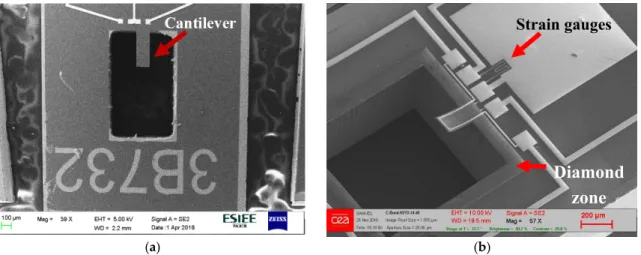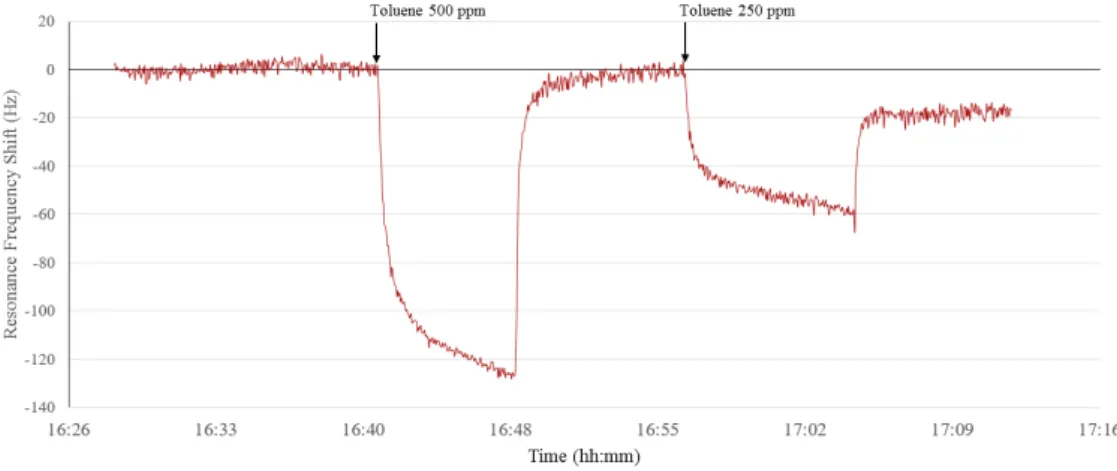HAL Id: hal-02440246
https://hal.archives-ouvertes.fr/hal-02440246
Submitted on 15 Jan 2020HAL is a multi-disciplinary open access
archive for the deposit and dissemination of sci-entific research documents, whether they are pub-lished or not. The documents may come from teaching and research institutions in France or abroad, or from public or private research centers.
L’archive ouverte pluridisciplinaire HAL, est destinée au dépôt et à la diffusion de documents scientifiques de niveau recherche, publiés ou non, émanant des établissements d’enseignement et de recherche français ou étrangers, des laboratoires publics ou privés.
Distributed under a Creative Commons Attribution| 4.0 International License
A Dedicated Gas Analysis System Based on Resonant
MEMS Sensors for Detection of Illicit Substances in
Cargo Containers †
Maira Possas, Lionel Rousseau, Farbod Ghassemi, Pedro González Losada,
Julien Pagazani, Gaelle Lissorgues, Massiel Habchi, Emmanuel Scorsone
To cite this version:
Maira Possas, Lionel Rousseau, Farbod Ghassemi, Pedro González Losada, Julien Pagazani, et al.. A Dedicated Gas Analysis System Based on Resonant MEMS Sensors for Detection of Illicit Substances in Cargo Containers †. Proceedings, MDPI, 2017, 1, �10.3390/proceedings1040601�. �hal-02440246�
Proceedings 2017, 1, 601; doi:10.3390/proceedings1040601 www.mdpi.com/journal/proceedings
Proceedings
A Dedicated Gas Analysis System Based on Resonant
MEMS Sensors for Detection of Illicit Substances
in Cargo Containers
†Maira Possas 1,*, Lionel Rousseau 1, Farbod Ghassemi 1, Pedro González Losada 1, Julien Pagazani 1, Gaëlle Lissorgues 1, Massiel Habchi 2 and Emmanuel Scorsone 2
1 ESYCOM ESIEE Paris, Noisy le Grand, France; lionel.rousseau@esiee.fr (L.R.);
farbod.ghassemi@esiee.fr (F.G.); pedro.gonzalezlosada@esiee.fr (P.G.L.); julien.pagazani@esiee.fr (J.P.); gaelle.lissorgues@esiee.fr (G.L.)
2 Diamond Sensors Laboratory, CEA LIST Gif-sur-Yvette, France; Massiel.HABCHI@cea.fr (M.H.);
emmanuel.scorsone@cea.fr (E.S.)
* Correspondence: maira.possasabreu@esiee.fr; Tel.: +33-1-4592-6696
† Presented at the Eurosensors 2017 Conference, Paris, France, 3–6 September 2017. Published: 8 August 2017
Abstract: In this work, a dedicated gas analysis system has been designed to interface resonant
micro-cantilever sensors for the detection of illicit substances for the inspection of container and large-volumes freight. In a previous work, we have fabricated diamond micro-cantilever sensors which have been coated with a sensitive layer. A gas analysis cell was developed to hold 8 sensors and allow them to be easily changed. A dedicated electronic read-out circuit provides low-noise detection of all sensors output signal. To complement this existing technology, we are designing a new system to accurately tune temperature and flow parameters of the analyzed gas. In parallel, micro-cantilever sensors have been optimized to increase sensor and gauge sensitivities.
Keywords: gas analysis; resonant sensors; MEMS; micro-cantilevers; synthetic diamond; illicit
substances; cargo containers; polymers
1. Introduction
Cargo containers plays an essential role in the world’s economy as approximatively 90% of world’s trade is carried by maritime transport [1]. Despite the fact that the number of container is dramatically increasing during last 10 years, only a few percentage of shipping containers can be inspected. The efficient inspection of bulk freight is critical to the security and economy as containers can be used for smuggling (e.g., of tobacco and protected species), illegal immigration, drug trafficking and in worst case, might be used by terrorists to transport dangerous substances like chemical, biological or nuclear weapons.
In this context, artificial sniffers can complement other inspection technologies in order to provide discrimination between many substances [2]. These systems have the advantage of being very sensitive, fast, easy of use and adapted to human being detection since it is considered as a passive inspection method.
In previous works [3,4] we demonstrated the development of an autonomous system based on an array of 8 micro-cantilever sensors for gas detection. This system is able to extract in real time (1 reading/s) the frequency response of all MEMS cantilevers by using an innovative mixed-signal processing circuit featuring self-diagnostic and automatic-calibration. In this work, this existing system has being adapted in order to satisfy the application in the field of detection in cargo containers.
Proceedings 2017, 1, 601 2 of 5
2. Materials and Methods
In order to use a sniffer system in the field of detection in cargo containers, temperature and sampling conditions must be adapted to allow the use of large volume samplers. Moreover, existing micro-cantilevers sensors have being optimized in order to increase mass sensitivity. Figure 1 shows a schematic of the proposed system (in red the existing technology and in yellow, the adaptations proposed in this work). The main parts that compose the system are described on the following sections.
Figure 1. Global architecture of gas analysis system based on MEMS sensors. In this work, the existing
system must be adapted to container inspection applications. In this case, sensors have been optimized and heaters are now necessary to adapt the system and the sampler method (thermodesorption).
2.1. Sensors
The sensor consists of a diamond micro-cantilever attached to a support chip (2.2 mm × 5.2 mm). The read-out of sensors is made by three metallic contact pads that allow electrical connection to the integrated pair of strain gauges that serve as transducing elements. The previous version [1] of sensors (Figure 2a) didn’t allow an integrated actuation. In the new version (Figure 2b) metallic strips have been integrated in order to allow Lorentz-Force actuation.
(a) (b)
Figure 2. SEM images of polycrystalline diamond micro-cantilevers (a) Previous version; (b) New
version.
In order to improve signal-to-noise ratio, on the new version of sensors, the strain gauges designs have also been adapted. Moreover, synthetic diamond layer has been optimized in order to cover only a specific zone and avoid etching problems during fabrication. Thanks to this solution, the new micro-cantilever allows the electrochemical deposition of sensitive layers.
Diamond
zone
2.2. Processing Electronic Circuit
In the previous work, a low noise and highly reconfigurable electronic system has been designed as well as a dedicated human-machine interface. The main board is composed of a micro-controller, a signal generation circuit to excite the sensors around their resonance frequencies and an analog processing chain to extract the amplitude of each sensor response. The system is able to measure the sensor frequency profile and track the resonance frequency by finding the maximum amplitude of the signal, but with a very poor signal-to-noise ratio. In this work, we have adapted data processing to fit the raw data of the frequency profile using an adequate mathematical Cauchy function. Moreover, a new board featured with a micro-controller was added in order to control temperature and flow as well as to provide communication between all the parts of the new system. An image of the electronic boards and the gas cell is showed on Figure 3.
Figure 3. Integrated gas analysis cell and electronic circuits.
2.3. Integrated System
All parts of the system presented on the previous section have been integrated in a single box. The thermodesorber is connected to the system through a heated inlet which temperature can be controlled by the micro-controller. The same micro-controller also controls the temperature of the gas cell. The gas flow through the system can also be digitally controlled by setting up the pump that pulls air from the inlet through the gas cell to the outlet. Communication between the system micro-controller and the sensor micro-micro-controller is done through an I2C bus.
(a) (b)
Figure 4. Pictures of the Sniffer System (a) A global view of the system: opened box containing the
integrated system, the thermodesorber and a computer for human-machine interface (b) Another view of the system where we can see more details of the thermodesorber.
Proceedings 2017, 1, 601 4 of 5
3. Results and Discussion
In this work, many aspects of previous Sniffer system have been improved and adapted to cargo container inspection applications. As discussed in Section 2.2, we have adapted data processing to fit the raw data of the frequency profile using an adequate mathematical Cauchy function. Figure 5 is an example of the error on frequency estimation using old (red line) and new method (blue line). As expected, the use of Cauchy function has contributed to improve frequency estimation accuracy. Figure 6 is an example of detection of Toluene using the new system together with new sensors. The characterization of mass sensitivity has shown that the new version of our sensors can achieve 450 Hz/ng, which represents 2.15 times the sensitivity of the first version.
Figure 5. Error on resonance frequency estimation using “maximum value” method and using
“Cauchy fitting” method as a function of resonance frequency.
Figure 6. An example of detection of Toluene at 500 ppm and 250 ppm using new version of diamond
cantilevers coated with PECH and new version of detection system.
Acknowledgments: This work was supported by European Community’s Seventh Framework Program (FP7)
334 under grant agreement No. 285203 (FP7 SNIFFER PROJECT) and is continuing within the European project 335 No. 653323 (H2020 C-BORD PROJECT).
Conflicts of Interest: The authors declare no conflict of interest.
References
1. Grassley, C.E.; Baucus, M.; Thomas, B.; Rangel, C.B. Container Security: Expansion of Key Customs Programs
will Require Greater Attention to Critical Success Factors; GAO-03-770; U.S. General Accounting Office:
Washington, DC, USA, 2003.
2. Joo, B.-S.; Huh, J.-S.; Lee, D.-D. Fabrication of polymer SAW sensor array to classify chemical warfare agents. Sens. Actuators B Chem. 2007, 121, 47–53.
3. Possas, M.; Rousseau, L.; Ghassemi, F.; Lissorgues, G.; Scorsone, E.; Bergonzo, P. Fabrication and micromechanical characterization of polycrystalline diamond micro-cantilevers. In Proceedings of the IEEE 2014 Symposium on Design, Test, Integration and Packaging of MEMS/MOEMS (DTIP), Cannes, France, 1–4 April 2014.
4. Abreu, M.P.; Ghassemi, F.; Rousseau, L.; Lissorgues, G.; Habchi, M.; Scorsone, M. Detecting volatile organic compounds using a resonant microcantilever-based system. In Proceedings of the IEEE 2016 Symposium on Design, Test, Integration and Packaging of MEMS/MOEMS (DTIP), Budapest, Hungary, 30 May–2 June 2016.
© 2017 by the authors. Licensee MDPI, Basel, Switzerland. This article is an open access article distributed under the terms and conditions of the Creative Commons Attribution (CC BY) license (http://creativecommons.org/licenses/by/4.0/).


